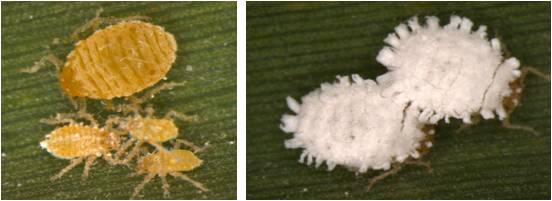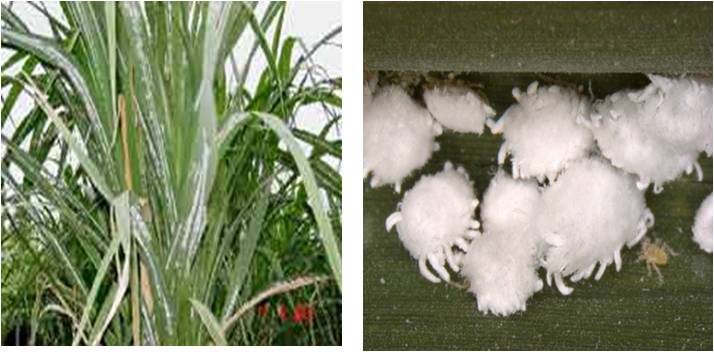Sugarcane Sap and Foliage Feeders :: Major Pests :: Sugarcane Woolly Aphid
5. Sugarcane woolly aphid: Ceratovacuna lanigera (Aphididae: Hemiptera)
Distribution and status: India. It has been posing threat as a major pest in Maharashtra since a few years and is fast spreading to new areas.
Damage symptoms
It is a congregation of large number of white coloured nymphs and adults on the undersurface; honeydew secretion with sooty mould on upper surface of the leaves. Canes with short internodes and narrow leaves with reduced girth. |
| |
Bionomics
Yellowish alate nymphs white in colour with less powdery substance. Two forms of adult viz., apterate and alate occur. Alate forms predominantly white in colour. Apterate often possesses crenulated margins of wax glands in rows. Such wax glands are absent in alate forms. C. lanigerae produces parthenogenetically and has an holocyclic (absence of sexually producing generation) life cycle. Cornicles are highly atrophied in adults. Population peaks from early August to September and again from November to February. The season from March to July appears to be a lean period. High rainfall temporarily retards proliferation, which re-colonizes with the cessation of rains. |
|
Management
1. Monitor the fields especially areas under shade where the colony establishes first.
2. Avoid transport of sugarcane for crushing from SWA infested area.
3. If seed material is to be moved, treat setts in malathion 0.1% solution for 15 minutes, pack in gunny bags and transport without using green or dry leaves as packing or cushion material.
4. Practice wide-row/paired-row planting and de-trashing that allow greater aeration and light.
5.Avoid late application of nitrogenous fertilizer and excessive irrigation.
6. Spray infested crop with acephate 75 SP 2.0 kg or monocrotophos 36 WSC 2.0L or dimethoate 30EC 2.0 L in 1000 L of water directing the spray fluid towards the under surface of leaves. Un-infested clumps in about 3 metre radius of the infested clumps may also be similarly treated with the insecticide.
7. Collect leaves bearing predators from other parts of the field and release
8.Mass produce predators viz.,Dipha aphidivora , Micromus igorotus and Eupeode confrater in shade-net houses and release them in infested fields |
|
|



